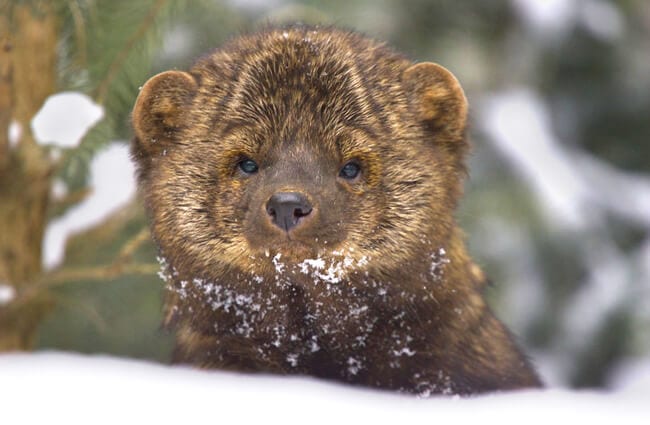
Fisher
Speak up for Fishers, WIPED OUT before, STOP TRAPPING, ESA protections NEEDED
FISHER are in the mustelid family along with otters, weasels, mink, marten, and wolverine. They are larger and darker than mink and marten and smaller than wolverine. Fisher have long bodies, short legs, rounded ears, and a bushy tail. Males are ~ 20% larger than females and weigh almost twice as much. Fishers are solitary secretive rare carnivores dependent on mature mixed-stand old growth forests with plenty of snags, rotten wood, and a sufficiently moist habitat. The Northern Rocky Mountain fisher are believed to still occur between Southwestern Montana to Northern Idaho.

It is unknown how many fisher occurred in the Northern Rockies before the trapping boom in the late 1800’s and early 1900s, but fisher were heavily targeted and decimated by trappers. “There are accounts from the 1920s of fisher pelts selling for the exceptional price of $345— equivalent to 7 months salary for a logger at the time—amplifying trapping pressures and possibly causing local extinctions. Historical records show that when fisher pelt values were at their highest, trappers would pursue an individual fisher for days. Not surprisingly this kind of pressure caused fisher numbers to plummet, and by 1930 they were thought to be extirpated from the northern Rockies, essentially “trapped out.”
Although the name, fisher, is misleading as they do not really prey much on fish, they are, however, a major predator skilled at killing porcupine. With the fisher population wiped out and the financial loss to trappers there was also a boom in the 1950’s in the porcupine population causing much concern to loggers. Appeasing both, fisher reintroduction efforts ensued in the late 1950’s into Montana and Idaho. “A total of 188 animals were relocated from BC and the upper Midwest over about three decades, with the hope that this would be enough for fisher populations to reestablish themselves in the northern Rockies.“
Montana opened a trapping of fisher for the 1983/84 trapping season with a quota of 20 animals, all required to be tagged and reported.
“But by the 1990s, the general consensus among wildlife biologists and conservationists was that the post-reintroduction fisher geographic distribution and population size in the Rockies was largely a mystery requiring study.”
Despite their rarity and the Montana Fish & Wildlife Commission’s eventual reduction in fisher quotas, trapping intentionally and incidentally of fisher continues in our state. Although trapping of fisher is illegal in Idaho reports show fisher are trapped and killed, too, while trapping for marten, bobcat, and wolves. In Idaho a total of 22 fishers were captured and 15 died in traps set for wolves during 2011/2012 trapping season.
By 2017, the distinct northern Rocky Mountain Fisher population was under review for Endangered Species Act protections!
“We’re looking for everything from personal observations and anecdotal stuff to highly structured research,” FWS spokesman Ryan Moehring said. “The more scientific and rigorous it is, the more useful it is, but we look at everything that comes through the door.”
Yet, in October 2017, despite the Northern Rocky Mountain fisher being genetically distinct and the numbers remaining unknown, fisher were denied listing under the ESA along with 18 other species petitioned. The USFWS concluded although trapping of fisher remains legal in Montana and fisher are incidentally trapped and killed in both Montana and Idaho, trapping does not pose a significant threat to these animals. “However, we ask the public to submit to us at any time any new information that becomes available concerning the stressors to any of the species listed above or their habitats.” Jodi Bush, Field Supervisor, Montana Ecological Services Field Office, 406-449-5225, ext. 205.
Fisher Montana Trapping Regulations
Montana Wolf & Furbearer Regulations, Fisher page 16. https://fwp.mt.gov/binaries/content/assets/fwp/hunt/regulations/2022/wolf-and-furbearer-final-for-web.pdf
For Fisher Quotas and annual trapping reports https://trapfreemt.org/trapping-quotas/
“Trapping the Holy Grail.”
Just what it means to trap the rare Fisher according to trapper’s testimony before the Montana FWP commissioners July 13, 2016 hearing.
Trappers selfish greed took characteristic precedence over the Fisher trapping 2016/17 proposals. After meeting with the Montana Trappers Association, FWP Commissioners rescinded their recommendation to reduce the Fisher quota from 7 to 0. They will now have a quota of 5 from 4 management units, 2 areas of which they are unknown to even occur and 2 will have a subquota of 1 female.
Killing one female Fisher is considerably, if they are lucky enough to find a mate, much more than killing 1 Fisher. These animals experience delayed implantation. They also breed again right after giving birth. Their pregnancy, birthing, and/or care for dependent young then correlate to Montana’s furbearer trapping season, December 1 – February 15. In addition, the smaller the population the more the individuals matter for necessary genetic exchange, population viability and stability.
Where is the science in trapping these rare creatures who have yet to even have a management plan according to FWP? How many are there? Why didn’t they survive in some of the areas they were previously introduced to after they were eradicated?
From the May trapping proposals hearing, trappers testified Fisher aren’t important to them to trap and that they get caught incidentally in trap sets for Marten.
We can’t help but wonder if trappers since took a look at these rare creatures and their fur value. In just 8 yrs Fisher’s pelts in Montana went from $35 to $104 on average.
FWP Commissioners told attendees, we can always adjust quotas another year.
In 2017 “The U.S. Fish and Wildlife Service conducted a one-year status review of fishers to determine if they warrant protections under the Endangered Species Act.” Even in Idaho where more fishers are believed to occur, it is illegal to trap them. http://bit.ly/29UgANA

Photo courtesy: Zaxtor
UPDATE On July 13, 2016, Fishers lost to trapper special interests in Montana. Despite fishers being under a year long review by the USFWS as to whether they warrant ESA protections, Montana FWP Commissioners voted to continue the legal trapping of fishers for the 2016/2017 furbearer trapping season.
After the one year review, in October 2017, the USFWS concluded although trapping of fisher remains legal in Montana and fisher are incidentally trapped and killed in both Montana and Idaho, trapping does not pose a significant threat to these animals and they were denied any protections under the ESA.
FISHERS, MTA, & QUOTA SETTING
Montana Trappers Association (MTA) OPPOSED FWP Commissioners Proposal to Reduce Fisher 2016 Quota to 0 because they claim on social media,
“The Montana Trappers Association helped MTFWP in the relocation of the 1980’s fisher to D1. Their intent was to use fisher to lower the porcupine population.” The animal rights activists are now trying to use the non native population as an excuse to close down trapping and access to fisher “habitat”.
The truth be told, Fishers were extinct in Montana by the 1930’s (Foresman 2012). Fisher extirpations were attributed to trapping, predator control, and habitat destruction. (Weckwerth and Wright 1968, p. 977; Brander and Books 1973, p. 53; Douglas and Strickland 1987, p. 512; Powell and Zielinski 1994, p. 39).
Reintroduction efforts in 1959 and 1960 in Lincoln, Granite and Missoula counties resulted in the establishment of populations in those counties.
The legal trapping of Fisher in Montana runs Dec 1 – Feb 15. This corresponds to gestation periods as Fishers reproduce by delayed implantation. Trapping further impacts future populations of the rare Fisher beyond the current 7 quota.
No specific information on Fisher reproductive biology is available for Montana. Information gathered in other portions of the range suggests that Fishers breed in late February to April or March to May. Females probably mate within days of giving birth. The implantation of the embryo is delayed for 11 months after mating. Parturition occurs approximately one month after implantation and renewed development of the embryo (Foresman 2012) – (Fisher-Montana Field Guide 2016)
New born kits are entirely dependent and may nurse for 10 weeks or more after birth. When they are 1 year of age, kits have established their own home ranges and are no longer dependent upon adults. Populations of fisher fluctuate in size, and reproductive rates may vary widely from year to year in response to the availability of prey. (FWS)
Fishers kill and feed on porcupine, another animal that is trapped and that we have no population estimates on other than FWP reports porcupine too are on the decline. “Where Have all the Porcupines Gone?” http://fwp.mt.gov/mtoutdoors/HTML/articles/2015/porcupines.htm#.V1W-evkrLDd
Fishers are also predators of snowshoe hares, squirrels, mice, and birds. “As dietary generalists, fishers tend to forage in areas where prey is both abundant and vulnerable to capture. The physical structure of the forest and prey associated with forest structures are thought to be the critical features that explain fisher habitat use, rather than specific forest types.” (FWS)
Fishers are highly prone to localized extirpation, their colonizing ability is somewhat limited, and their populations are slow to recover from deleterious impacts (FWS 2012).
According to Montana FWP Harvest reports, 70 Fishers were reported trapped and killed during the 2004-2013 Montana furbearer trapping seasons. Fisher pelt prices have soared from an average of $28 in 2004 to $145 in 2013!
Despite the high price in Montana for fishers, a quota of 7, and the average of 7 Fisher reported killed over the past 10 years, the number of Fisher reported trapped in the 2015 season dropped to 4. Is this indicative the Fisher is on the decline?
As animals become more rare, the more valuable their pelt. At the FWP Commissioners public hearing on May 12, 2016, Montana Trappers Association president publicly expressed while he didn’t care about trapping Fisher he did not want to see pelts go to waste. To the best of our knowledge in Montana, accidental trapped animals that are killed are not required to be wasted and are used for educational and scientific purposes.
Since the Commissioner’s hearing, the North American Fur Auction announced, irregardless of a decline in fur prices, a strong demand for Sable aka Marten and for Fisher selling at 100%! Major purchasers of Fisher were Hong Kong and Greece, sparking a whole new interest of late from Montana trappers on the 0 quota Fisher proposal.
The Montana Trappers Association posted they need to trap and kill Fishers arguing ” trapping is vital to the data these biologists need to continue their studies on the overall population. If they continue to be trapped and killed the studies will demonstrate the population overall is gone. FWP reports the “Fisher sample sizes are extremely small, so they do not represent any population trend.” (Furbearer Progam Statewide Harvest & Management Report 2013-2014 Montana)
On June 1, 2016, Montana Trappers Association posted on their social media, Facebook page to oppose the 2016 furbearer proposal of reducing Fisher quota to 0, stating “Trappers usually do not set for fisher and are often caught in a marten set.”
Yet only 1 fisher is reported accidentally trapped in the Montana FWP non-target 2012-2015 reports, in which a Fisher was killed in a conibear trap set for marten up Roaring Lion in the Bitterroots of Hamilton. So what has become of these fishers “often caught in marten sets” in Montana?
Existing as a small, low-density population magnifies threats posed to the fisher by trapping, disease, habitat loss, and other factors. (Biological Diversity Northern Rockies Fisher Petition)
It is past time to STOP TRAPPING FISHER. This is one cause of death that is easily preventable!
Copyright © 2023 All Rights Reserved 2016 ACTION ALERT Trap Free Montana Public Lands
Resources and References
https://www.fws.gov/mountain-prairie/species/mammals/fisher/
http://fieldguide.mt.gov/speciesDetail.aspx?elcode=AMAJF01020
http://fwp.mt.gov/mtoutdoors/HTML/articles/2015/porcupines.htm#.V1W-evkrLDd
http://www.nafa.ca/strong-competition-for-both-sable-and-fisher/
https://www.westernwatersheds.org/issues/species/fisher/
https://www.regulations.gov/document/FWS-R6-ES-2015-0104-0138